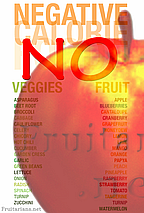In a presentation published on youtube, Chef AJ, who is certified in "Plant-Based Nutrition" from Cornell University, describes the concept of calorie density, promoting weight loss. She claims that you can eat as many of non-sweet fruit and other low in starch vegetables you want, because:
"...their mostly waner, and fiber and nutrients, you know, you actually spend more calories, chewing non-starchy vegetables and digesting them than in the calories."
My response:
Why every lecture like this must contain some nonsense? One hour chewing burns only ~10 food calories!
There is no scientific evidence to show that any vegetables or fruits have a zero or negative caloric impact.
Celery has a thermic effect - "the amount of energy expenditure above the resting metabolic rate due to the cost of processing food for use and storage" - of ~ 8%, much less than the 100% or more required for a food to have "negative calories". A large piece of celery provides almost 10 calories, but the body expends less than one calorie processing it.
Proteins require the most energy to digest but their a thermic effect is 20%–30% only. A commonly used estimate of the thermic effect of food is about 10% of one's caloric intake.
Chef AJ replied through her profile Wight Loss Wednesday:
After I provided a link to this article with explanation to a viewer who replied to me with ""chewing and digesting".. digestion does not come for free," Chef AJ responded to my comment as well. First she said:
I was talking about BMR.
Then she shared this link:
http://lethow.com/health/negative-calorie-foods/
In this article they just repeat the false information:
Consuming Negative calorie foods will burn more calories in chewing and digestion process as compared to the calories they provide for the body. Eating these foods will create a calorie-deficit in the body, ultimately helps in weight loss.
Towards the end they admit that:
Our body uses around 10-15% of calories of the food we eat, in order to digest them. Our body also needs energy to break down the food compound and absorb carbohydrates, proteins, minerals fats, and other nutrients. Our body generates energy from the food we intake.
But they also imply that much more energy is burned by absorption of food. After mechanical and chemical digestion, which require most energy to break the pieces and molecules of food down, they assume or try to make you believe that absorption through the small intestine into the blood would take more than 90% of the calories of these foods for the total to be negative! There is no known scientific foundation for such assumptions. It even goes against common sense to think that the mere absorption of broken down nutrients would require ~10 times more energy than actual breaking down, or to imagine that we could survive with such inefficient bodies. Even if this were true, nutrients from other foods would require similar amounts of energy to be absorbed.
Basal metabolic rate (BMR) is the minimal rate of energy expenditure, usually per day or hour. The measurement requires a strict set of criteria to be met, which include being in a physically and psychologically undisturbed state, in a thermally neutral environment, and in the post-absorptive state (after the food is digested). I do not know what exactly Chef AJ was pointing towards here.
They also list most non-starchy vegetables and fruits as calorie-negative! How irresponsible. The site, which calls itself "the ultimate guide," does not list any links to their sources, of course. They don't even have about pare or sign their articles. This site looks like an advertisement project, with the content created entirely by paid-per-word copywriters.
As a fruitarian whose energy comes primarily from those fruits, I would be dead not only by now, but after any couple of month period in the last 20+ years.
These are the fruits and vegetables they list:
| Fruits | Vegetables | Spices |
|
Apples Apricots Blackberries Cantaloupes Cranberries Grapefruit Guava Lemons Oranges Papayas Peaches Pineapples Plums Prunes Raspberries Strawberries Tangerines Tomatoes Watermelon |
Asparagus Aubergine Beets Broccoli Cabbage Carrots Cauliflower Celery Chicory Cress Cucumbers Dandelion Endive Fennel Green beans Lettuce Onions Radishes Spinach Turnip Zucchini |
Anise Cayenne Chili peppers Cinnamon Cloves Coriander/Cilantro Cumin Dill Fennel seeds Flax seeds Garden cress Garlic Ginger Parsley Mustard seeds Watercress |
Please, don't believe just anyone on the internet, always check the information you rely upon.

